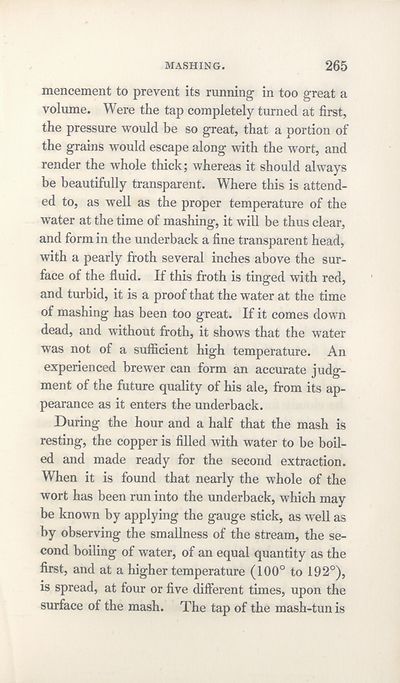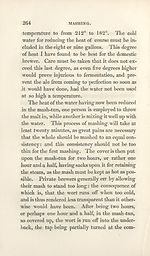Download files
Complete book:
Individual page:
Thumbnail gallery: Grid view | List view

MASHING.
265
mencement to prevent its running in too great a
volume. Were the tap completely turned at first,
the pressure would be so great, that a portion of
the grains would escape along with the wort, and
render the whole thick; whereas it should always
be beautifully transparent. Where this is attend¬
ed to, as well as the proper temperature of the
water at the time of mashing, it will be thus clear,
and form in the underback a fine transparent head,
with a pearly froth several inches above the sur¬
face of the fluid. If this froth is tinged with red,
and turbid, it is a proof that the water at the time
of mashing has been too great. If it comes down
dead, and without froth, it shows that the water
was not of a sufficient high temperature. An
experienced brewer can form an accurate judg¬
ment of the future quality of his ale, from its ap¬
pearance as it enters the underback.
During the hour and a half that the mash is
resting, the copper is filled with water to be boil¬
ed and made ready for the second extraction.
When it is found that nearly the whole of the
wort has been run into the underback, which may
be known by applying the gauge stick, as well as
by observing the smallness of the stream, the se¬
cond boiling of water, of an equal quantity as the
first, and at a higher temperature (100° to 192°),
is spread, at four or five different times, upon the
surface of the mash. The tap of the mash-tun is
265
mencement to prevent its running in too great a
volume. Were the tap completely turned at first,
the pressure would be so great, that a portion of
the grains would escape along with the wort, and
render the whole thick; whereas it should always
be beautifully transparent. Where this is attend¬
ed to, as well as the proper temperature of the
water at the time of mashing, it will be thus clear,
and form in the underback a fine transparent head,
with a pearly froth several inches above the sur¬
face of the fluid. If this froth is tinged with red,
and turbid, it is a proof that the water at the time
of mashing has been too great. If it comes down
dead, and without froth, it shows that the water
was not of a sufficient high temperature. An
experienced brewer can form an accurate judg¬
ment of the future quality of his ale, from its ap¬
pearance as it enters the underback.
During the hour and a half that the mash is
resting, the copper is filled with water to be boil¬
ed and made ready for the second extraction.
When it is found that nearly the whole of the
wort has been run into the underback, which may
be known by applying the gauge stick, as well as
by observing the smallness of the stream, the se¬
cond boiling of water, of an equal quantity as the
first, and at a higher temperature (100° to 192°),
is spread, at four or five different times, upon the
surface of the mash. The tap of the mash-tun is
Set display mode to:
![]() Universal Viewer |
Universal Viewer | ![]() Mirador |
Large image | Transcription
Mirador |
Large image | Transcription
| Antiquarian books of Scotland > Occupations > British wine-maker, and domestic brewer > (303) |
|---|
| Permanent URL | https://digital.nls.uk/126003557 |
|---|
| Description | Thousands of printed books from the Antiquarian Books of Scotland collection which dates from 1641 to the 1980s. The collection consists of 14,800 books which were published in Scotland or have a Scottish connection, e.g. through the author, printer or owner. Subjects covered include sport, education, diseases, adventure, occupations, Jacobites, politics and religion. Among the 29 languages represented are English, Gaelic, Italian, French, Russian and Swedish. |
|---|

